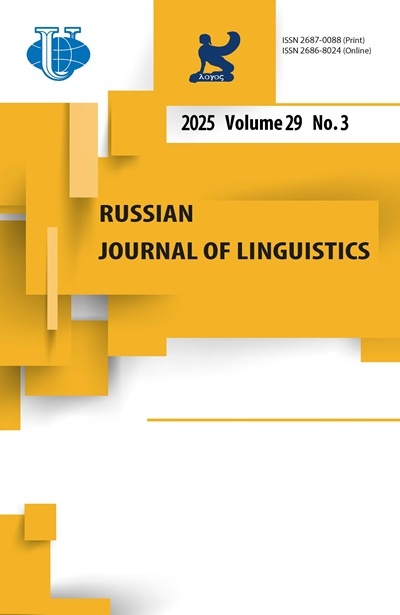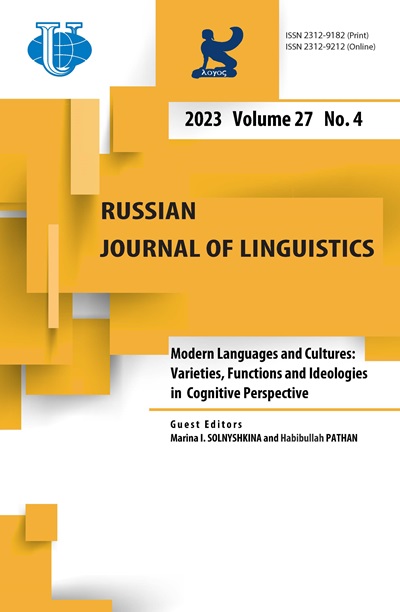Mari Wiklund. 2023. Speech and Interaction of Preadolescents with Autism Spectrum Disorder: Focus on Prosody, Disfluencies and Comprehension Problems. Singapore: Springer Nature Singapore
- Авторы: Сусанто С.1
-
Учреждения:
- Университет Бандар Лампунг
- Выпуск: Том 27, № 4 (2023): Современные языки и культуры: вариативность, функции и идеологии в когнитивном аспекте
- Страницы: 1012-1016
- Раздел: РЕЦЕНЗИИ
- URL: https://journals.rudn.ru/linguistics/article/view/37241
- DOI: https://doi.org/10.22363/2687-0088-36707
- EDN: https://elibrary.ru/XLWPVU
- ID: 37241
Цитировать
Полный текст
Аннотация
-
Полный текст
Wiklund’s book “Speech and Interaction of Preadolescents with Autism Spectrum Disorder” is a comprehensive exploration that advances our understanding of communication dynamics in individuals with Autism Spectrum Disorder (ASD). The multidimensional approach taken by the author distinguishes this work, as it explores various facets of speech and interaction. This broad scope makes the book an invaluable resource for researchers seeking a nuanced understanding of communication complexities in the ASD population. The scholarly nature of the book is evident in its detailed analyses and research methodology. The subsequent exploration of disfluencies unveils not only the frequency but also the qualitative differences in the speech of preadolescents with ASD compared to control groups. These disfluencies are shown to have a direct impact on comprehension problems, emphasizing the interconnectedness of speech production and comprehension in individuals with ASD.
The book consists of 7 chapters. It is structured to address multiple dimensions of communication challenges faced by individuals with ASD, providing an in-depth exploration of various aspects such as prosody, disfluencies, comprehension problems, gaze behaviour, therapists’ response strategies, and teaching orientations.
Chapter 1 introduces ASD and explains its main characteristics. ASD is a developmental disorder affecting how the brain develops, leading to difficulties in social interaction, communication, and repetitive behaviours. The chapter focuses on the unique way individuals with ASD speak, including limited pitch range, sing-song or bouncy speech, fast or jerky rhythm, quiet or loud voice, and other features. The chapter also explores the challenges people with ASD face in using language and interacting socially. This includes issues with understanding and using speech, engaging in conversations, and interpreting non-verbal cues like eye contact. The discussion emphasizes that individuals with ASD often take language literally, missing implied messages and showing avoidance behaviours. Despite these challenges, the chapter concludes by recognizing that individuals with ASD share some communication traits with neurotypical peers. This perspective highlights the complexity and diversity in the communication patterns of individuals with ASD, emphasizing the importance of understanding beyond just the difficulties they may experience.
Chapter 2 traverses the complex world of prosody, breaking down its different parts and highlighting its overall nature. It discusses how neurotypical Finnish-speaking adults perceive the prosody of preadolescent boys with ASD as unusual when compared to controls of the same age and gender, based on a study by Wiklund et al. (2022). This difference is linked to specific prosodic features, such as sing-song pitch, bouncing pitch, disconnected speech rhythm, large pitch changes, and flat pitch, sometimes creating the impression of a non-native accent. It references Wiklund’s earlier work (2016), highlighting that creaky voice is a common prosodic feature causing comprehension issues in interactions between preadolescents with ASD and neurotypical adults. However, the chapter emphasizes that prosodic features are rarely the main cause of comprehension issues, stressing the importance of exploring the relationship between prosody and comprehension challenges in individuals with ASD. Additionally, the chapter discusses a study by Wiklund et al. (2021), revealing that individuals with ASD effectively use pitch rises at the end of their utterances as a means of interaction. These findings challenge traditional assumptions about the communicative abilities of individuals with ASD and provide a deeper understanding of their prosodic skills.
Chapter 3 explores interruptions in speech, known as disfluencies, and how they affect conversations. It focuses on preadolescents with ASD, showing they have more interruptions than neurotypical peers. This difference in speech patterns sheds light on communication dynamics. The chapter emphasizes not only counting but also understanding the types of interruptions in ASD, such as word searches and grammatical errors. The control group has simpler interruptions. This qualitative difference helps us grasp disfluency in ASD and reveals speech challenges unique to this group. The chapter also looks at how interruptions impact understanding in conversations, suggesting that for those with ASD, interruptions may contribute to comprehension problems, setting them apart from the control group. This insight emphasizes the importance of considering interruptions in both producing and understanding speech in individuals with ASD.
Chapter 4 scrutinizes the difficulties in communication between preadolescents with ASD and their neurotypical therapists. The chapter shows that misunderstandings are common in these interactions, but not all of them lead to behaviour issues, adding complexity to our understanding of the link between comprehension and behaviour. It identifies key reasons for comprehension challenges, such as unclear references and topic shifts, echoing previous research by Geller (1998) that highlighted similar issues in school-aged children with ASD. The findings highlight the tendency for individuals with ASD to interpret language literally, especially struggling with figurative or implied language. The chapter emphasizes the significance of non-verbal communication, noting that trouble often arises when there's no eye contact. This lack of visual engagement, along with overlapping speech, indicates that difficulties in non-verbal cues, particularly eye contact, play a crucial role in comprehension challenges for individuals with ASD during interactions.
Chapter 5 investigates how people with ASD use their eyes during communication. The focus is on the challenges posed by non-verbal aspects, shedding light on distinctive behaviours such as avoiding eye contact, commonly observed in ASD literature. Gaze behaviour is regarded as a crucial element influencing interactions, impacting conversations and potentially leading to misunderstandings. Drawing from Wiklund's work (2012), the study employs conversation analysis and a multimodal approach to uncover three primary patterns employed by preadolescents with ASD to avoid eye contact: staring straight ahead, looking around, and concentrating on their hands while speaking. This detailed examination enhances our comprehension of how individuals with ASD adjust their visual engagement in social interactions. It also highlights that, despite their initial reluctance to make eye contact, they occasionally employ it at the conclusion of their speaking turn as a form of feedback, underscoring the adaptability of their gaze behaviour. Furthermore, it reveals the intricate interactional skills of them, illustrating how they initiate narratives and interpret implicit meanings in conversations through a combination of words, intonation, and gestures.
Chapter 6 examines how therapists work with preadolescent boys with ASD who speak both French and Finnish in group sessions. The chapter is divided into two main parts: therapists' responses and teaching approaches. In the first part, it looks at how therapists guide group discussions to help the kids learn about conversation topics. It focuses on how therapists respond and shape the discussions, aiming to validate input and maintain good communication among the children. The second part looks at how therapists teach during these group sessions. Interestingly, the chapter suggests that prosodic skills (intonation, rhythm) are often not explicitly taught, with a focus instead on general social norms and body language. This indicates that therapists prioritize broader aspects of social interaction over specific speech-related skills in this therapeutic setting.
This book offers a comprehensive coverage of the current state of knowledge in the field of ASD, specifically focusing on the speech and interaction patterns of preadolescents. By taking a multidimensional approach, Wiklund aims to provide a thorough understanding of the intricacies involved in communication for preadolescents with ASD. The strength of this book lies in its examination of prosody, which includes the melody, rhythm, stress, and other suprasegmental features of speech. The author not only highlights the atypical prosodic features perceived by neurotypical individuals but also explores how these features contribute to comprehension problems in interactions between individuals with ASD and their neurotypical counterparts. The book goes beyond mere identification of challenges; it provides insights into the potential use of prosody as an interactional resource for preadolescents with ASD, showcasing a more perspective on their communicative abilities.
Furthermore, the exploration of disfluencies adds another layer to the understanding of speech production challenges in preadolescents with ASD. Wiklund uncovers not only the higher frequency of disfluencies in this population but also the qualitative differences, highlighting the complex nature of their speech patterns. Importantly, the link between disfluencies and comprehension problems is emphasized, shedding light on the critical role of speech production in effective communication for individuals with ASD.
While the book provides a thorough and insightful exploration of various dimensions related to communication challenges in preadolescents with ASD, it is essential to acknowledge certain limitations in its scope and approach. One limitation is the potential for a lack of generalizability of findings. The book primarily focuses on preadolescent boys with ASD, and the extent to which the findings can be extrapolated to preadolescent girls or individuals at different developmental stages is not explicitly addressed. ASD is known for its heterogeneity, and its characteristics may vary significantly across individuals. Therefore, a broader sample representation could enhance the applicability of the book’s findings to a more diverse population within the ASD spectrum.
Additionally, the book may benefit from a more explicit discussion of cultural and linguistic factors. ASD manifestations and communication styles can be influenced by cultural and linguistic diversity, and this aspect is not extensively explored in the book. Considering the global nature of ASD, a more examination of how cultural and linguistic factors intersect with communication challenges could contribute to a more comprehensive understanding of the subject. Furthermore, the book predominantly emphasizes challenges without delving deeply into potential strengths or adaptive strategies employed by preadolescents with ASD in communication. A more balanced exploration of both challenges and strengths could offer a richer and more holistic perspective on the communication abilities of individuals with ASD.
In conclusion, the book stands as an insightful exploration of the communication dynamics in preadolescents with ASD. It takes a holistic approach by inquiring into various facets of speech and interaction, shedding light on the challenges faced by individuals within the autism spectrum. The book provides a well-rounded understanding of the multifaceted nature of communication difficulties in this population. Researchers, clinicians, and educators can benefit from the wealth of information presented, gaining valuable insights into the theoretical underpinnings of ASD-related communication challenges and practical strategies for improving interaction and communication skills. The comprehensive nature of the examination sets this book apart, making it a valuable resource for those seeking to deepen their understanding of communication in preadolescents with ASD and implement effective interventions to enhance their communicative abilities.
Об авторах
Сусанто Сусанто
Университет Бандар Лампунг
Автор, ответственный за переписку.
Email: susanto@ubl.ac.id
ORCID iD: 0000-0003-4551-0760
доцент кафедры английского языка педагогического факультета Университета Бандар Лампунг (Индонезия). Получил степень PhD в области лингвистики и фонетики в Университете английского и иностранных языков (Индия). В сферу его научных интересов входят фонетика, фонология, преподавание языков, конверсационный анализ и речевые нарушения.
ИндонезияСписок литературы
- Geller, Elaine. 1998. An investigation of communication breakdowns and repairs in verbal autistic children. The British Journal of Development Disabilities 44 (87). 71-85. https://doi.org/10.1179/096979598799156092
- Wiklund, Mari. 2012. Gaze behavior of pre-adolescent children afflicted with Asperger syndrome. Communication & Medicine 9 (2). 173-186. https://doi.org/10.1558/cam.v9i2.173
- Wiklund, Mari. 2016. Interactional challenges in conversations with autistic preadolescents: The role of prosody and nonverbal communication in other-initiated repairs. Journal of Pragmatics 94. 76-97. https://doi.org/10.1016/j.pragma.2016.01.008
- Wiklund, Mari, Kia Ihaksinen & Martti Vainio. 2021. Autismikirjon poikien intonaation käyttö kysymys-ja kerrontavuoroissa spontaanissa vuorovaikutuksessa [The use of intonation in questions and narrative turns in the spontaneous interaction of boys afflicted with autism spectrum disorder]. Puhe Ja Kieli 41 (1). 43-70. https://doi.org/10.23997/pk.107691
- Wiklund, Mari, Lari Vainio, Satu Saalasti & Martti Vainio. 2022. Puheen prosodian havaittu epätyypillisyys suomenkielisillä autismikirjon varhaisnuorilla [Perceived atypicality of speech prosody of Finnish-speaking preadolescents with autism spectrum disorder]. Puhe Ja Kieli 42 (4). 309-330. https://doi.org/10.23997/pk.12745
Дополнительные файлы















